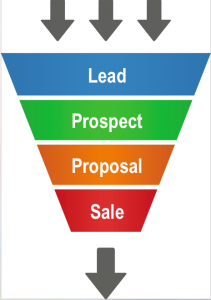Content Marketing and the Sales Process
Content Marketing is defined as
a type of marketing that involves the creation and sharing of online material (such as videos, blogs, and social media posts) that does not explicitly promote a brand but is intended to stimulate interest in its products or services. (Google)
I like to think of it this way: Content Marketing delivers information to suspects and prospects. Information that is designed to move them closer to the buy decision. Or, to customers, to reinforce their good decision (to buy from you) and move them towards another sale, cross sale or up sale.
 The Problem with Content
The Problem with Content
Many consider content marketing too ethereal. That it doesn’t focus on the main selling points that we want prospects to hear or read. That it doesn’t talk about our product, its features and benefits! Content marketing can be downright painful for a sales-oriented person. Why would we spend time, energy, space and money on putting out information that doesn’t directly communicate the product we want prospects to buy?
That is a good argument. It is similar to those who don’t believe awareness advertising is money well spent. That building awareness is something for big brands and consumer packaged goods companies. Many don’t want to be in the business of building brand recognition… they want to sell product. And they are absolutely right.
However, content marketing does have an important role to play in helping sell. That role is not only at the very beginning of the funnel (creating awareness and interest), but can be utilized throughout the sales process and even after the sale.
Redefining Content Marketing
What if we redefined content marketing as a sales support tactic? In doing so our source for content would start with the sales cycle or the steps in the sales process. Consider your sales cycle or funnel. You have certain steps along the way to the sale: identification, qualification, specification, proposal, negotiation, close.
Each of these steps has content marketing messages “built in” to them. A powerful way to develop content ideas is simply to list the steps of your sales process (if you don’t have these defined, contact me, I can help). Then ask the question, “If you could deliver three messages, concepts, ideas to prospects at this step in the process, what would they be?” If you have six steps defined in your process, this exercise will result in 18 topics for content articles. These messages can be delivered through a variety of means.
Delivering Your Content
Typically, when you read about content marketing, it revolves around inbound marketing elemetns: the website and social media. The interesting content you develop is supposed to interest and engage people (suspects – people who may be prospects) and draw them to your company for more information.
However, the content we develop in support of our sales cycle can be used on the website and social media AND through outbound and direct selling marketing channels. It’s a mistake for the content team to be focused solely on inbound marketing.
If we develop our content first from a sales support perspective, then that should be our first use of it. Do we do a good job during the sales process of over communicating (yes, OVER communicating) the value proposition, brand attributes and features/benefits of our products and company?
For instance: Does an email (or if you are old school, a handwritten note) go out after a sales call with a thank you for the meeting? Such an email could include links to the website content appropriate to that step in the sales prospect:
Based on our conversation, I thought of a couple additional details that may be useful information:
• How our engineering specification process ensures you get the exact fit product. (this line would be a link to web content)
• Ways our return policy protects you from buying the wrong item. (this line would be a link to web content)
The examples would change based on the type of your business, but the bottomline is that you can build your content marketing messages out of your sales process. The messages will be appropriate and useful as web and social media content (if shaped in the right context). The content is also useful for direct delivery to the prospect (or customer) at each step of the sales process.
Deliver the Whole Package
Many companies I talk with struggle to develop content. This is one method to create a framework for creating content that will satisfy the sales manager and the marketing communications team. It permits a well rounded, 360 perspective and use of content. It ensures that the message is consistent and purposeful.
If you need help planning your marketing or your content development processes, we can help. Contact us to discuss.

